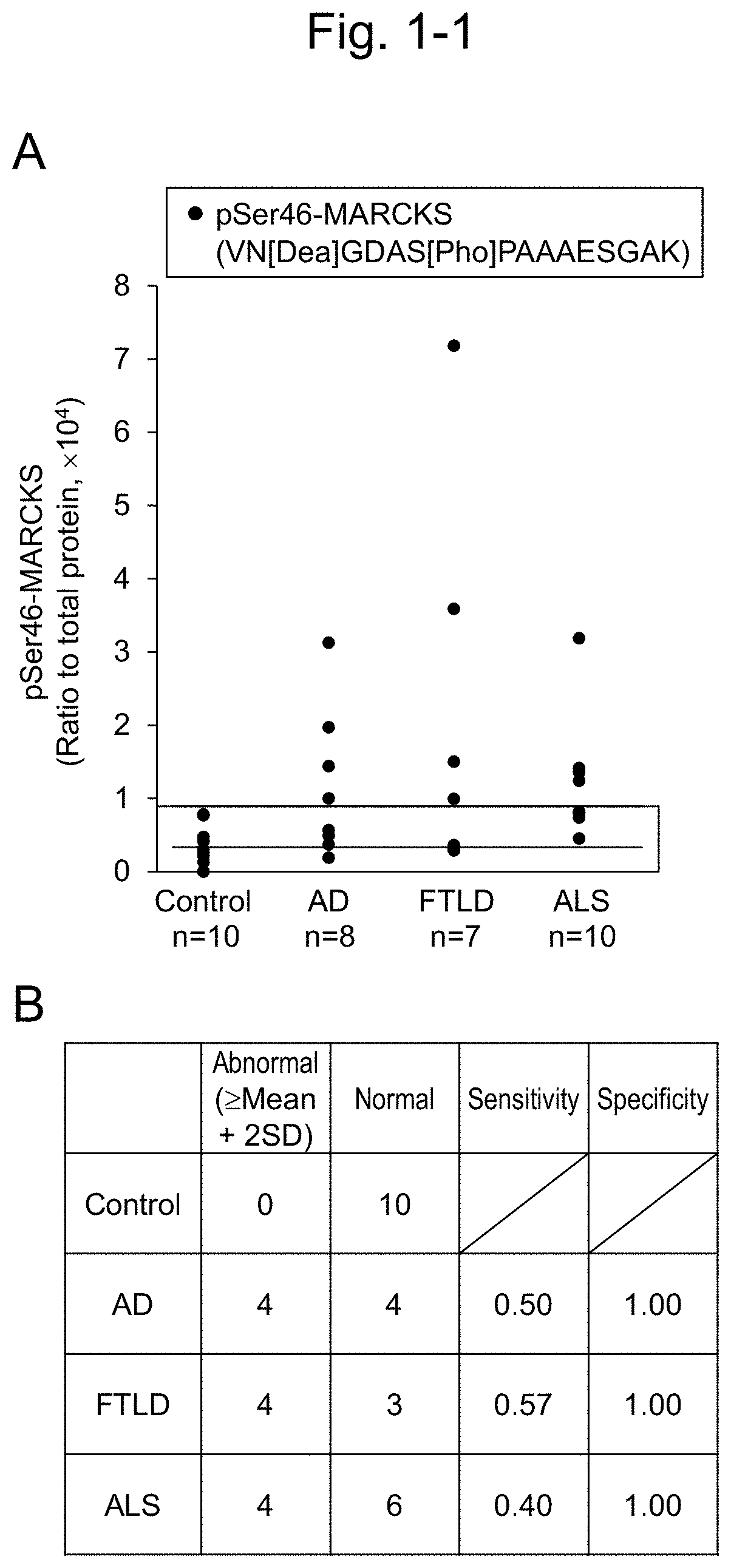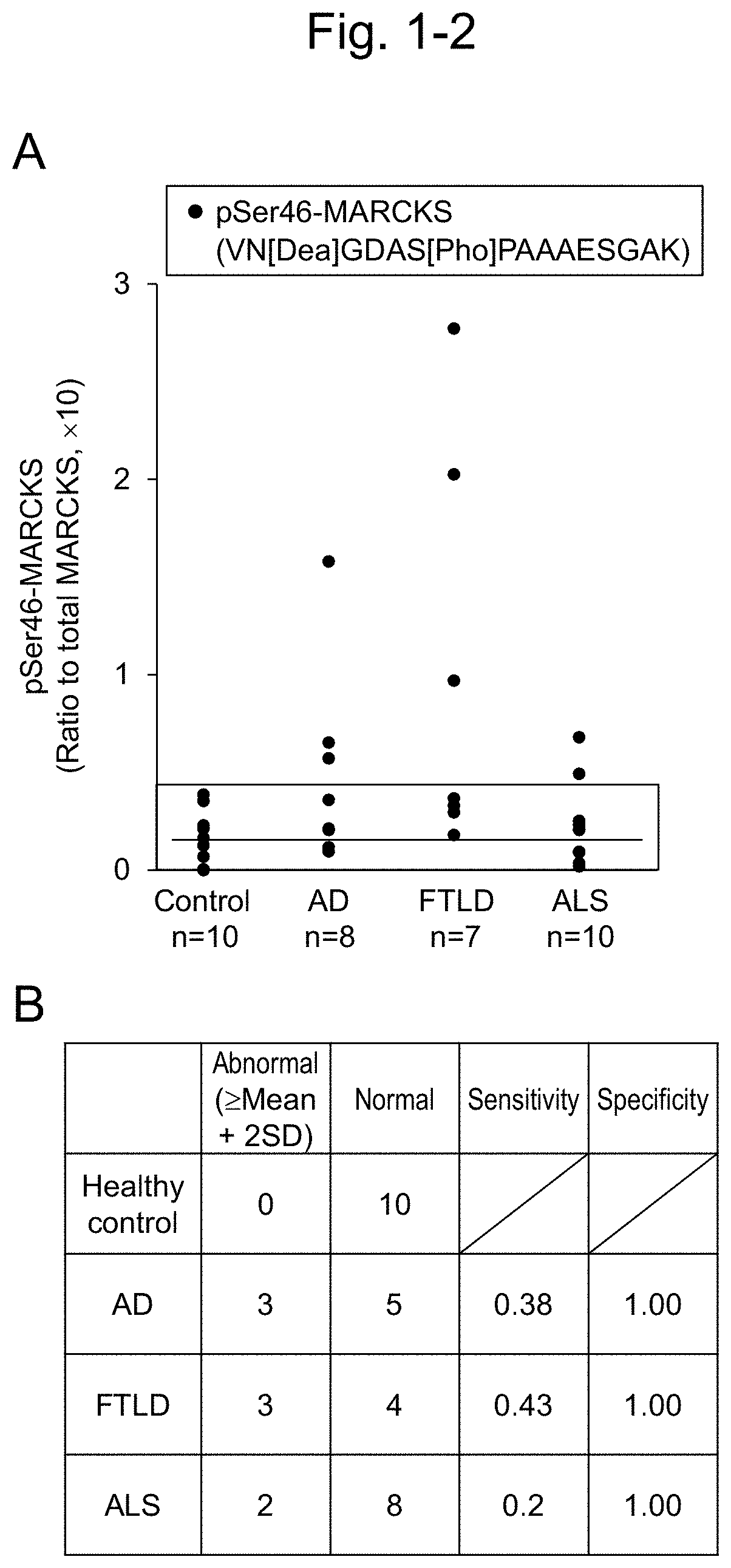Detection of alzheimer's disease (AD), frontotemporal lobar degeneration (FTLD), amyotrophic lateral schlerosis (ALS), parkinson's disease (PD), and dementia with lewy bodies (DLB) indicated by phosphorylation of marcks
a technology of frontotemporal lobar degeneration and detection method, which is applied in the detection of post translational modifications, instruments, biochemistry apparatus and processes, etc., can solve the problem of insufficient recovery from dementia as clinical signs are present, and achieve high specificity and high sensitivity
- Summary
- Abstract
- Description
- Claims
- Application Information
AI Technical Summary
Benefits of technology
Problems solved by technology
Method used
Image
Examples
example 1
[Example 1] Study on Alzheimer's Disease (AD), Frontotemporal Lobar Degeneration (FTLD), and Amyotrophic Lateral Sclerosis (ALS)
[0146]Methods
[0147]Human Patients
[0148]Cerebrospinal fluids were taken from 8 AD patients, 7 FTLD patients, and 10 ALS patients who were diagnosed in Nagoya University and Tohoku University, based on clinical symptoms, electrophysiological examination, and neuroimaging including MRI, SPECT, and PET, and put in use.
[0149]Control subjects were 6 males (55 to 83 years old, average age: 72.6) and 4 females (69 to 79 years old, average age: 75.5). The scores of the mini mental-state examination (MMSE) of them when the cerebrospinal fluid (CSF) was collected were 25 or more (26 to 30, average: 28.3). AD patients were 2 males (54 and 80 years old) and 6 females (57 to 75 years old, average: 64.5 years old). The MMSE scores of these patients were not more than 25 (4 to 25, average: 17.1) and the average and range of the FAB scores were 9.3 and 6 to 13, respectively...
example 2
[Example 2] Study on Parkinson's Disease (PD) and Dementia with Lewy Bodies (DLB)
[0192]Methods
[0193]Mouse PD / DLB Models
[0194]Normal humanized α-Syn-BAC-Tg mice were produced in accordance with the method described in Yamakado et al (2012) Neurosci Res 73: 173-177.
[0195]More specifically, a BAC-Tg construct (PAC AF163864 and BAC AC097478, including a 28 kb 5′-flanking sequence and 50 kb 3′-flanking sequence in addition to all human genes) was micro-injected into C57BL6 / J eggs to produce homozygous α-Syn-Tg mice. GBA-hetero-KO mice were purchased from the Jackson Laboratory (B6.12956-Gbatm1Nsb / J, stock number 003321) and mated with humanized α-Syn-BAC-Tg mice. The obtained normal humanized α-Syn-BAC-Tg / GBA-hetero-KO (homo / hetero) mice were maintained as a lineage.
[0196]Mating of α-Syn-BAC-Tg / GBA-hetero-KO mice were repeated for 10 generations or more and the mice of 1, 6, and 24 months old (N=3) were used for immunohistochemical and biological analyses.
[0197]Immunohistochemical Analys...
PUM
| Property | Measurement | Unit |
|---|---|---|
| pH | aaaaa | aaaaa |
| pH | aaaaa | aaaaa |
| ion spray voltage | aaaaa | aaaaa |
Abstract
Description
Claims
Application Information
 Login to View More
Login to View More - R&D
- Intellectual Property
- Life Sciences
- Materials
- Tech Scout
- Unparalleled Data Quality
- Higher Quality Content
- 60% Fewer Hallucinations
Browse by: Latest US Patents, China's latest patents, Technical Efficacy Thesaurus, Application Domain, Technology Topic, Popular Technical Reports.
© 2025 PatSnap. All rights reserved.Legal|Privacy policy|Modern Slavery Act Transparency Statement|Sitemap|About US| Contact US: help@patsnap.com



